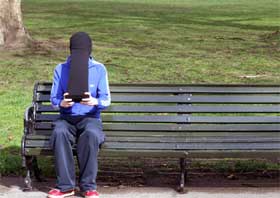to make : marble magnets
  (mini tropical vacation) | I finally gave in and made marble magnets. Not surprisingly they are quite fun, smooshing the glue out to make a perfect little magnified image is very satisfying. Here, in order of appearance, are the places I referenced:
I bought all of these supplies at Michael's, including the glue I went back for since I got the wrong kind to start with. I bought 1/2" and 3/4" round (strong) magnets (in with the frames, near the corks); 1/2" and 3/4" clear flat glass marbles (in the fake flowers aisle, check the mosaics section too); silicon sealer made by the Crazy Glue people (in the glue aisle). All of the pictures were cut out of Lucky magazine, in the last five issues. I hope I'm not violating any laws by showing them here. These are great packaged in those Altoid-sized tins, I've seen them in office/gift shops like that. I was very tempted to get googly eyes, and those flat bottomed plastic jewels (the ones in the bead aisle which don't have holes in them, you know?) and make sets of those. However, the plastic jewel colors weren't exciting me at the time. You can also do marble push pins, bracelets and chokers and rings, hair clips, heck you could just skip the magnet part and glue marble pictures to, say, a lamp. | |
 | First I thanked myself for saving all those magazines. Then I hunted through for tiny pictures, I used the marble itself to test, then traced a circle the size of the magnet and cut it out with scissors. A perfectly sized craft hole punch would save a lot of time here. | |
 | Gathering the stuff - silicon glue, cut out pictures, magnets, and marbles. I put paper down so I wouldn't ruin my cheap Ikea coffee table. Ok, at this point I have to admit my initial failing. I, of course, didn't check to see what type of glue would be best before I went to the store so I got Crafter's Goop first. I'm sure it works really really well, but man does it smell strongly! It's been three days since my first try and it's still at the stage where you sniff it once, but not again because you know it can't be good for your lungs. I went back, and on advice from the Paper Candy instructions, found silicon glue. It doesn't have a strong odor and seems to just work just right. | |
 | note: I forgot a step. A few people suggest gluing down a white round of cardstock first (junk mail comes in great here) as the glue can seep through your picture and show the dark magnet underneath if you don't. It didn't seem to affect my magnets, I used magazine pictures which are fairly flimsy, however I will have to test it to see if my whites could be whiter. I used a toothpick to spread a thin layer of the glue on the magnet, and put the picture down over that. I had a few seconds to slide the picture into place if needed. I used a toothpick because really strong glue in squeezey metal containers hates me and gloops everywhere. I squeezed a tiny amount of the silicon glue onto some paper and used the toothpick from there. No traumatic events occurred and I don't need to go back to Ikea to replace the table. | |
 | Using the toothpick again, I dabbed a bit of glue, about the size of a lentil, onto the middle of the picture. | |
 | Lower the marble straight down onto the glue. | |
 | And press down in the center. You can see the glue spreading out to the corners making a nice seamless, hopefully bubble less, magnet. Any of those ripples on the bottom of the marble will magically disappear. This whole thing is very satisfying. | |
 | One word of warning, some of my marbles were too small and the pictures stuck out. Really though they won't show once they're on the fridge. I hope. At first I was wary of how thick the magnets themselves are, but now I appreciate it as it gives the whole thing enough height to hold on to when you're prying it off the fridge door. Um... I feel like I'm forgetting to say something. I'll let you know when I remember what it was. | |
 | small update: I made these at night under my living room lamp (thus the bad photos), and the marbles seemed fine. But in the light of day I discover they have scratches on the outer surface. Nothing bad, just not quite the perfection it seemed. So do make sure you have decent light, as if you needed to hear me say that. | |
 | update 12.23.02 I read about cabochons at this thread and this thread on Glitter, I didn't quite know what they were. I found some at Tap Plastics while I was there - they make them in 1" and 1/2" sizes. I bought some 1" ones and made some Christmas magnets, they are the two bottom and middle one in the picture at the left. The pictures at the Tap Plastics website is sort of unclear, they are solid half spheres, there is no hollow space in the middle. The 1/2" cabochons Tap carried were just slightly too small to fit over my 1/2" magnets. | |
  | A picture of the side and the bottom - I used the 3/4" magnets. To make these I pressed the cabochon onto the picture first and allowed to set, then I attached the magnet. You can buy these individually at a Tap Plastics, or in quantities of 100 from thier website. Tap Plastics has stores in California, Oregon and Washington. I am sure there are other places to find them or order them online as well. The Glitter threads talk about using plastic cabochons for making marble jewelry. note: if you're wondering where to buy blank Altoids style tins, or other style tins, see Impress Rubber Stamps (look under Packaging), or try a Japanese stationary store if there is one near you. via: http://www.notmartha.org/tomake/marblemagnets |














































